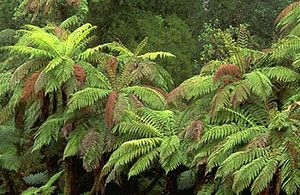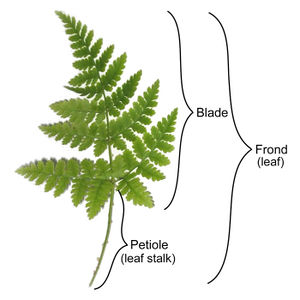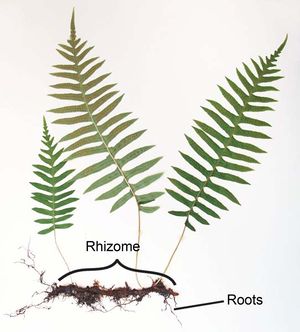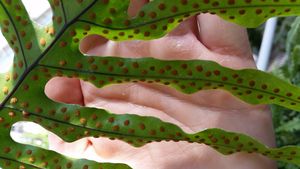Fern
Ferns are a type of a vascular plant characterized by spores, complex leaves, and the lack of seeds and flowers. Ferns belong to a class of plants known as Polypodiopsida, which is further divided into 4 extant subclasses; Equisetidae, Marattiidae, Ophioglossidae, and Polypodiidae.[1] Ferns are thought to have originated some 359 million years ago during the Devonian period, but it is possible that this group of vascular plants is even older.[2] There is a wide range of sizes that ferns can grow to, some of the smallest ferns can be 1-2 cm in height, while the some of the tallest ferns (tree ferns) can grow anywhere from 10-25 meters.[2]

Classification
Ferns are an ancient group of vascular plants that are considered to be one of the earliest plants to move onto land.[3] The oldest known ferns are found to be from the late Devonian period around 360 million years ago, but many modern fern families and species are thought to have started appearing in the Cretaceous period, 145-66 million years ago.[4] This diversification of fern families is referred to as the “great fern radiation”.[4] Today there are 4 living sub-classes ferns, but throughout their history there has been 4 sub-classes that have gone extinct. Below are descriptions of the 4 extent sub-classes:
- Equisetidae: This sub-class consists of vascular plants called horsetails. These are close relatives to true ferns and also reproduce via spores and characterized by a whorl of branch-like leaves.[1]
- Marattiidae: This sub-class separated from the other fern groups early on in their evolutionary history and is made up of about 100 species. These ferns are known for their extremely large leaves and fleshy rootstocks.[1]
- Ophioglossidae: This sub-class is not as diverse as the other sub-classes The members of this sub-group are known as the whisk ferns, grape ferns, adder's-tongues and moonworts.[1]
- Polypodiidae: these ferns are referred to as leptosporangiate ferns and are the largest of the 4 sub-classes with around 11,000 species. This is the most diverse sub-class of ferns and contains many of the wellknown ferns.[1]
Morphology
Leaves

Ferns are an extremely diverse group, and this diversity results in a plethora of unique shapes and sizes. Even though there is a large degree of variability in the leaves of ferns, many ferns share some general morphological similarities.[5] The leaves of ferns are typically referred to as “fronds”.[6] Fronds consist of two parts; the stem (stalk) which is referred to as the “petiole” and the “leaf blade” which is the vegetative organs that extend laterally from the petiole.[5] The leaf blade is often separated into individual segments called “pinnae” which is made up of several leaflets known as “pinna”.[6] Despite the variation in leaf morphology, fern leaves play an important role in the growth, survival, and reproduction of the fern. Photosynthesis takes place in the leaves of the fern and is vital to the survival of the plant, but the leaves can also help to disperse spores for reproduction, house nitrogen-fixing bacteria, allow the fern to reproduce vegetatively, and collect falling nutrients/organic matter that fall from above the leaves.[5]
Stems

The stems of ferns are called “rhizomes” and are usually found underneath the fern, buried under some type of substrate, most commonly soils and mosses.[6] The rhizomes can extend either laterally or vertically and serves as the connection between the aboveground leaves and the underground roots.[6] In ferns there are two types of stems: long-creeping stems and short-creeping stems. Long-creeping stems have a longer length which allows the fronds to be more spaced out, while short-creeping stems are shorter and tend to have the fronds closer together.[6]
Roots
The roots of ferns are not entirely different from the roots of seed-producing plants and serve many of the same functions. Roots grow out of the rhizomes (stem) of the fern and extend deeper and further into the growth substrate.[6] Fern roots are thin and spread out in order to provide structural integrity to the fern. The roots are an important structure that assists with the uptake of water and various soil nutrients which are essential elements the fern needs to thrive.[6]
Distribution
Today it is estimated that a total of 10,500 distinct species of ferns exist, but there could potentially be more than 15,000 species because new species are continuously being found in unexplored areas and some groups of ferns are poorly understood.[2] The diversity of ferns results in a wide distribution that spans multiple continents and biomes. Ferns can be found on every continent on earth except Antarctica. The greatest distribution of ferns is found in tropical areas, specifically tropical rain forests where its possible to find over 100 different species in just a few hectares.[2] Even though the greatest richness of ferns is found in the tropics that does not mean that is the only place they are found. Ferns can also be found in temperate and some artic environments.[2] Generally fern diversity and abundance decreases as one goes from the equator to the poles with the least number of ferns found in artic environments.
Habitat
Similar to its distribution, ferns can inhabit a wide range of habitats. While a majority of ferns prefer moist tropical forests, they can also be found high in elevation on mountains, in deserts growing in/on rocks, open/abandoned fields, and even in wetlands and bodies of water.[2] The most common habitat for the majority of ferns are damp and warm areas, which makes tropical rain forests a prime habitat for a number of different fern species, but certain species have adapted to a variety of abiotic conditions, such as temperature, precipitation, sunlight, and substrate type. Ferns are often considered an important plant for succession because they are able to colonize such a wide range of different habitats.[2] Some ferns have even been observed to be epiphytes and grow on other plant species, such as trees.[2]
Reproduction

Unlike seed plants, ferns utilize tiny, microscopic spores that are contained in a specialized structure called the sporangia (plural: sporangium), typically on the underside of leaves.[2][3] The spores are dispersed mainly by wind and water and can be carried long distances from the parent plant.[3] Spores that happen to land in suitable habitats will crack and begin to germinate, growing into a gametophyte.[3] The gametophyte is a structure that houses the reproductive organs of the plant: the antheridium and the archegonium.[3] The sperm swims from the antheridium to the archegonium where the egg is located, although water is required for this to happen which stresses the need for a relatively moist environment.[3] Once the sperm finds the egg the fern begins its life and starts to grow back into the sporophyte.[3]
Some ferns can reproduce asexually through a reproductive strategy known as vegetative reproduction. Vegetative reproduction is essentially growing a new plant from a removed part of the parent plant.[7] In some ferns this is achieved through specialized bulbs that fall off the fern and begins to grow into a new plant, but this may also work with fragments from the parent plant such as leaves.[8] This reproductive method does not disperse the offspring very far from the parent.[2]
Influence on Soil
Ferns can have a significant effect on the soil they grow on and play an important role in the carbon concentration in the soil.[9] Being an understory plant ferns can catch falling organic matter for higher up in the canopy.[10] The material caught by the ferns resulted in an increase in decomposition rate because the ferns had more efficient decomposers than the soil did.[10] A study in 2019 looked at how using ferns for restoration efforts could affect soil carbon (C). The results of this study showed that the presence of ferns contributed anywhere between 54% and 61% of the total soil C, mostly from leaf litter and dead root material.[9] This study also showed ferns influenced nutrient retention by reducing the loss of nutrients, like nitrogen, and increasing soil carbon storage.[9]
References
[1] Smith, A. R., K. M. Pryer, E. Schuettpelz, P. Korall, H. Schneider, and P. G. Wolf. 2006. A classification for extant ferns. Taxon 55:705–731.
[2] Wagner, Warren H. , Walker, Warren F. , Mickel, John T. , Yatskievych, George and Gifford, Ernest M.. "Fern". Encyclopedia Britannica, 12 Jun. 2020, https://www.britannica.com/plant/fern.
[3] Hill, T. 2015. Ferns. Organismal Diversity, Ohio State University. https://u.osu.edu/eeob3320/2015/03/06/ferns/#:~:text=The%20%E2%80%9Cgreat%20fern%20radiation%E2%80%9D%20is,period%20(Bhattacharya%2C%202009).&text=During%20the%20Carboniferous%20period%2C%20giant,to%2012%20meters%20in%20height.
[4] Plant Evolution II: Ferns. Cortland University. http://cortland.edu/waldbauer-trail/11-plant%20evolution-II.html#:~:text=The%20ferns%20and%20their%20relatives,to%2066%20million%20years%20ago.
[5] Vasco, A., R. C. Moran, and B. A. Ambrose. 2013. The evolution, morphology, and development of fern leaves. Frontiers in Plant Science 4:1–16.
[6] Fern Structure. US Forest Service, United States Department of Agriculture. https://www.fs.fed.us/wildflowers/beauty/ferns/structure.shtml#:~:text=The%20leaves%20of%20ferns%20are,and%20petiole%20(leaf%20stalk).&text=The%20midrib%20is%20the%20main,pinnae%3B%20single%20leaflets%20are%20pinna.
[7] Britannica, The Editors of Encyclopaedia. "Vegetative reproduction". Encyclopedia Britannica, 9 Aug. 2017, https://www.britannica.com/science/vegetative-reproduction.
[8] Fern Reproduction. US Forest Service, United States Department of Agriculture. https://www.fs.fed.us/wildflowers/beauty/ferns/reproduction.shtml
[9] Lyu, M., J. Xie, C. P. Giardina, M. A. Vadeboncoeur, X. Feng, M. Wang, L. Ukonmaanaho, T. C. Lin, Y. Kuzyakov, and Y. Yang. 2019. Understory ferns alter soil carbon chemistry and increase carbon storage during reforestation with native pine on previously degraded sites. Soil Biology and Biochemistry 132:80–92.
[10] Dearden, F. M., and D. A. Wardle. 2008. The potential for forest canopy litterfall interception by a dense fern understorey, and the consequences for litter decomposition. Oikos 117:83–92.